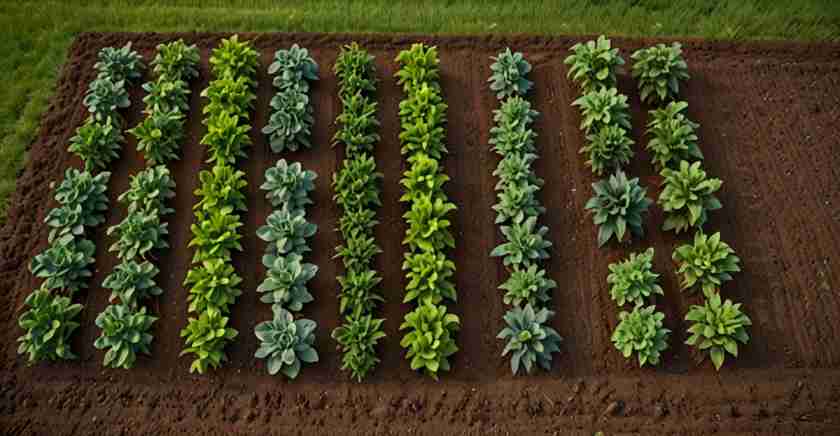Crop rotation is one of the oldest and most effective agricultural practices, dating back thousands of years. It involves growing different types of crops in the same area over sequential seasons to improve soil health, control pests, and boost productivity. Despite its simplicity, crop rotation offers numerous benefits that modern farmers can leverage to create sustainable and profitable farming systems.
In this blog post, we’ll explore the benefits of crop rotation for soil health and productivity, how it works, and practical tips for implementing it on your farm.
What is Crop Rotation?
Crop rotation is the practice of alternating crops in a specific order on the same piece of land. The sequence typically includes crops with different nutrient requirements, growth habits, and pest vulnerabilities. For example, a common rotation might include:
- Legumes (e.g., beans, peas) to fix nitrogen in the soil.
- Leafy Greens (e.g., lettuce, spinach) to utilize the nitrogen.
- Root Crops (e.g., carrots, potatoes) to break up soil compaction.
- Grains (e.g., corn, wheat) to add organic matter to the soil.
The Benefits of Crop Rotation
1. Improves Soil Health
Crop rotation enhances soil health by maintaining nutrient balance and organic matter.
How It Works:
- Nitrogen Fixation: Legumes like beans and peas have symbiotic bacteria in their roots that fix atmospheric nitrogen, enriching the soil for subsequent crops.
- Organic Matter: Different crops contribute varying amounts of organic matter, improving soil structure and fertility.
- Nutrient Balance: Rotating crops with different nutrient needs prevents depletion of specific nutrients.
Example: After growing nitrogen-fixing legumes, planting nitrogen-hungry crops like corn can maximize yields without excessive fertilizer use.
2. Reduces Soil Erosion
Crop rotation helps protect soil from erosion by maintaining ground cover and improving soil structure.
How It Works:
- Root Systems: Different crops have varying root structures that hold soil in place.
- Ground Cover: Rotating crops with different growth habits ensures continuous ground cover, reducing exposure to wind and water erosion.
Example: Alternating deep-rooted crops like alfalfa with shallow-rooted crops like lettuce can stabilize soil and prevent erosion.
3. Controls Pests and Diseases
Crop rotation disrupts the life cycles of pests and diseases, reducing their impact on crops.
How It Works:
- Host Disruption: Pests and diseases often target specific crops. Rotating crops makes it harder for them to establish and spread.
- Natural Predators: Diverse crops attract beneficial insects that prey on pests.
Example: Rotating corn with soybeans can reduce the population of corn rootworms, a common pest.
4. Enhances Weed Management
Crop rotation helps control weeds by disrupting their growth cycles and reducing their competitiveness.
How It Works:
- Allelopathy: Some crops release chemicals that inhibit weed growth.
- Shade and Competition: Tall or dense crops can outcompete weeds for light and nutrients.
Example: Planting cover crops like rye or clover can suppress weeds and improve soil health.
5. Boosts Crop Yields
By improving soil health and reducing pest pressure, crop rotation can lead to higher and more consistent yields.
How It Works:
- Nutrient Availability: Rotating crops ensures balanced nutrient use and availability.
- Disease Control: Healthy soil and reduced pest pressure lead to stronger, more productive plants.
Example: Farmers who rotate wheat with legumes often see increased wheat yields due to improved soil nitrogen levels.
6. Reduces Dependency on Chemical Inputs
Crop rotation minimizes the need for synthetic fertilizers and pesticides, lowering costs and environmental impact.
How It Works:
- Natural Fertilization: Legumes and cover crops add nutrients to the soil naturally.
- Pest Control: Diverse crops reduce the need for chemical pesticides.
Example: Rotating potatoes with mustard can reduce the need for chemical fungicides to control soil-borne diseases.
7. Promotes Biodiversity
Crop rotation encourages biodiversity by creating a more varied and resilient ecosystem.
How It Works:
- Habitat Diversity: Different crops provide habitats for a wide range of organisms.
- Genetic Diversity: Rotating crops with different traits enhances the genetic diversity of the farming system.
Example: Rotating crops like sunflowers, beans, and squash can attract pollinators and beneficial insects.
How to Implement Crop Rotation
1. Plan Your Rotation
Start by creating a crop rotation plan that suits your farm’s needs and conditions. Consider the following factors:
- Crop Families: Group crops by family (e.g., legumes, brassicas, grasses) and avoid planting the same family in the same area consecutively.
- Nutrient Needs: Alternate crops with high and low nutrient demands.
- Pest and Disease Cycles: Break pest and disease cycles by rotating susceptible crops with resistant ones.
Example Rotation Plan:
Year 1: Legumes (beans, peas)
Year 2: Leafy Greens (lettuce, spinach)
Year 3: Root Crops (carrots, potatoes)
Year 4: Grains (corn, wheat)
2. Incorporate Cover Crops
Cover crops like clover, rye, and vetch can be included in your rotation to improve soil health and suppress weeds.
Benefits of Cover Crops:
- Prevent soil erosion.
- Add organic matter and nutrients to the soil.
- Break pest and disease cycles.
3. Monitor and Adapt
Regularly monitor your fields to assess the effectiveness of your rotation plan. Be prepared to adapt based on soil tests, pest pressures, and crop performance.
Challenges of Crop Rotation
While crop rotation offers numerous benefits, it also comes with challenges:
1. Planning Complexity
Creating and managing a rotation plan requires careful planning and record-keeping.
2. Market Demands
Farmers may face pressure to grow high-demand crops continuously, making rotation difficult.
3. Knowledge and Experience
Effective crop rotation requires knowledge of crop families, nutrient cycles, and pest dynamics.
Conclusion
Crop rotation is a time-tested practice that offers significant benefits for soil health, pest control, and crop productivity. By diversifying crops and breaking pest and disease cycles, farmers can create more sustainable and resilient farming systems. While implementing crop rotation requires planning and effort, the long-term rewards—healthier soil, higher yields, and reduced input costs—make it a worthwhile investment. Whether you’re a small-scale farmer or managing a large operation, crop rotation is a powerful tool to enhance your farm’s productivity and sustainability.










